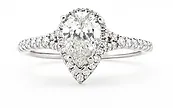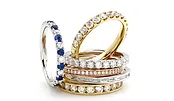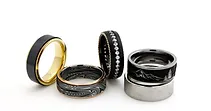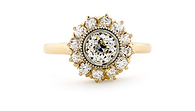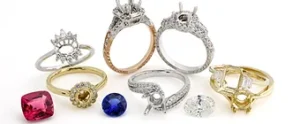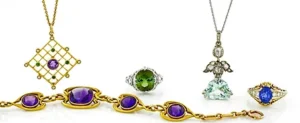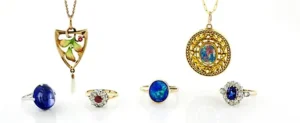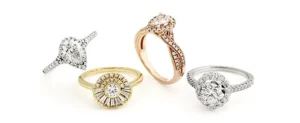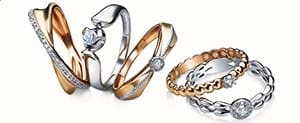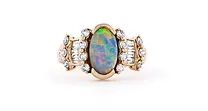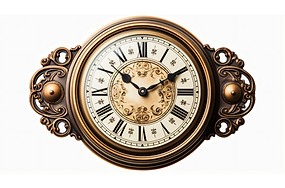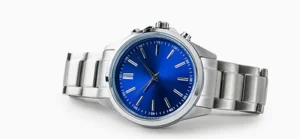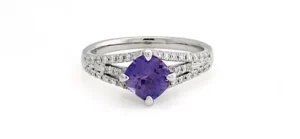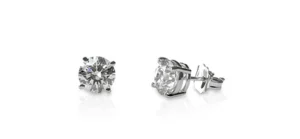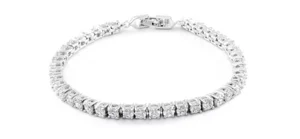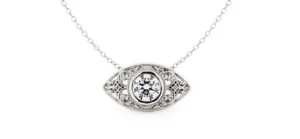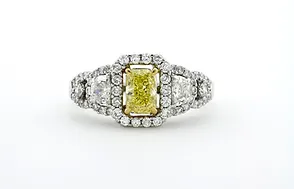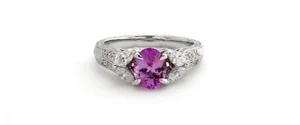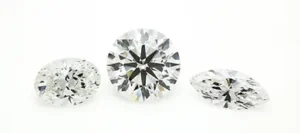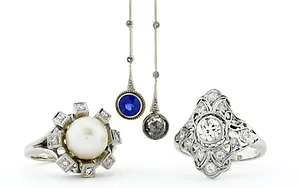Georgian Era Jewelry • Victorian Era Jewelry • Edwardian Era Jewelry • Art Nouveau
Art Deco • Retro Period • Mid Century Period • Modern Era Jewelry
Throughout history, art historians and jewelers have referred to jewelry from specific periods by name, since they often share certain traits and design elements. These names derive from periods of time and historical context, such as the Victorian era corresponding to Queen Victoria’s 60 year reign. Ancient and antique jewelry prior to year 1800 is exceptionally rare and fragile, as such we rarely offer it. Thus for our purposes, the key jewelry eras begin with Georgian jewelry from 1715-1830, which is the first era from which we regularly find jewels on offer, and the latest named jewelry era is the Mid Century Modern movement from 1960-1975. For any item that does not directly fall into a design era, we will give a circa date that places it within 10 years of the closest known date of manufacture. For items newer than 1975, we sell these items as modern estate or pre-owned. On this page we will give you the fundamentals of each era or time period.
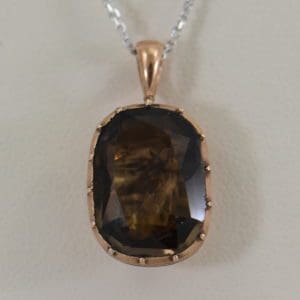
A Georgian Foil Backed Pendant in Rose Gold circa 1814
Georgian Era (1715 – 1830)
Jewelry from the Georgian period spanning most of the 18th and early 19th century is a very rare find on the market today. First, jewelry was much more expensive at this time, and gems were even rarer than they are today, making jewelry only affordable to the wealthy. Second, since these items were often worn daily, many have not survived hundreds of years of wear. Many that have survived have been altered or modified at some point in their history; thus original intact Georgian jewelry is scarce.
Georgian pieces are notable for two things: first is that they tend to look a bit less refined, with rough spots and a lack of finesse, and second is that Georgian buyers were sentimental, so every item has meaning. To address the rough hewn appearance, all of the jewelry of this period was hand-crafted with primitive tools. To set the scene, imagine a jeweler working by candle light, hand hammering and shaping gold ingots and other material into thin sheets before they could start the process of putting the jewelry together. From there, each gem was chosen and set by hand, items were engraved with tiny knives, etc. and each piece was a treasure to its owner. Even the Diamonds available at the time were table or rose cut Diamonds, which were not fully faceted, since optical science had not told us how to cut Diamonds yet. The result were pieces of jewelry that often look their age, with perfectly imperfect gems, noticeable repairs, and other signs of hand fabrication. The jewelry buyers wanted their items to be symbolic. Georgian rings often contain hidden signs, symbols, or expressions, Georgian lockets often contain locks of hair, and most of these items contain initials from the original owners. If you are trying to authenticate a piece of Georgian jewelry, first look for an absence of markings, then look for aged inscriptions. These are two good hints, coupled with design and manufacturing technique, that show an item’s age.
Victorian Era (1830 – 1900)
Victorian jewelry is some of the most coveted we offer, but due to the length of Queen Victoria’s reign, Victorian jewelry can look very different depending on where and when it was made, making it more difficult to identify. Queen Victoria was the first true celebrity, and influenced her subjects around the world by the choice of jewelry she wore and fashions she chose. During her reign the industrial revolution occurred, vastly changing the options available to jewelers in terms of metals and manufacturing techniques. In addition, colonial exploration discovered new gems and new sources of gems, making stones like Opal and Diamonds relatively affordable for the first time in history. Thus the Victorian era was really the jewelry renaissance, and some of the largest advances seen occurred during this 60 year span. There are a few constants: most pieces were made in gold, occasionally silver topped gold, Diamonds were scarce, and the bigger the item, the better.
As mentioned, there were a number of trends and fads that came and went throughout 19th century jewelry design. In the 1840s, exploration in Greece and the Northern Enlightenment made all things Neoclassical modern again- think designs like Greek key, Roman ruins, Egyptian scarabs, and Etruscan enamel. Queen Victoria’s purchase of Balmoral and love of Scotland popularized all things Scottish: agate jewelry, Scottish citrines (Cairngorm), and Celtic designs which stayed popular for 80 years. Then by the 1860s, two key developments were influencing fashion and design. First Prince Albert died, sending Victoria and the world into mourning. All things mourning jewelry and dark, like onyx and hair jewelry, became de jour, but also items similar to those Albert had given Victoria became popular too: like her snake engagement ring, crown topped heart brooch, and insect pendants. His sentimentality became romanticized. Further industrial advancements of the 1860s and 1870s put us into the Grand period of financial success, especially in America, which also made mass produced jewelry affordable for the first time. Think basic gold wedding bands, diamond solitaire rings, gold and silver chains, and simple bar brooches which the new middle class could afford, but which had not been affordable before then. By the 1880’s and 1890’s, artists started pushing back against the opulence of past years and the impersonal nature of machine produced items. The end of the 19th century was the Victorian Romantic era, when Victoria was in her twilight years, and the arts were getting renewed attention across the globe. Gone were the simple gold bands and machine made chains, in came hand production again and the beginnings of the Arts & Crafts movement. While awed by machines and technology, jewelers still liked the old ways, and were making rings using natural stones, making brooches in the shapes of animals and insects, etc. A love of nature and zest for life was visible in the fashion worn by the women of the day. Even mass produced items would be engraved and detailed, and we see more colored gems used than Diamonds. Despite a trend toward natural elements, Victorian jewelry tended to be symmetrical, formal, polished, and more classically proportioned.
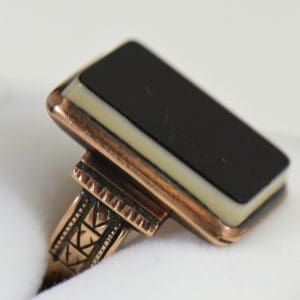
Victorian Rose Gold Mourning Ring in Black Agate Stone
The two iconic Victorian Engagement Rings have to include the halo ring and the snake ring. The halo ring has been around for centuries, but new Diamond mines in Brazil and South Africa made Diamonds affordable enough to use even for the middle class in the mid-19th century. These Diamonds would often surround natural Pearls, Opals, Sapphires, Rubies, Emeralds and rare gems from the Orient set in the center. If the recipient was lucky enough to receive a larger Diamond, it would have been rose cut (flat on back with facets on top) or old Mine Cut (cushion shaped with irregular facets) which were cut to catch the candle light. While Diamonds are commonly thought of as the engagement gem of choice today, they were not the gem of choice in Victorian times, instead they were used to accent a gem like a Sapphire or Ruby. Victorian buyers would choose a gem based on its hidden meaning- Rubies were meant to signify love and passion, Sapphires symbolized faith and hope. Victorian snake rings were often set with these gems as the heads or eyes to add layers of meaning. The snake itself was meant to portray everlasting love and devotion, which made it a romantic betrothal gift. Snakes worked their way into rings, snake bracelets, snake necklaces, snake brooches, and more.
Art Nouveau Period (1890 – 1920) & Edwardian Era (1900-1920)
The tail end of the Victorian era, with its Arts & Crafts elements, lead to the Art Nouveau period in France which was known by the Edwardian Era in most of the world. Today these eras mostly overlap and the terms are often interchangeable. The art nouveau period looked to nature themes, such as flowers, birds, plants, and even the mythical, like gods and nymphs, for its inspiration and style. Unlike the formal and proper Victorian items, Nouveau designs were informal, emphasized by dainty lines, curvature, intentional asymmetry and so forth which contrasted sharply from the rigid lines of jewelry that had gone before. Art Nouveau jewelers would work with specific material to stay on theme, they would use rough hewn or organic gems, like pearls and coral as centerpieces to provide texture. Instead of Diamond accents, they would work with more pearls, or even colored gemstones. The color green was all the rage, and small green demantoid garnets were often used as contrast in floral pieces. The diamond was taking a back seat, so to speak, while new materials such as molded glass, ivory, and enameling were used to develop new designs which were proving very popular with buyers of that day. Just as was happening in the world of visual arts like pottery and painting, an emphasis was placed on buying from local jewelers, artists, and supporting unique design. The kings of this movement were Louis Comfort Tiffany and Rene Lalique, who both used premier quality gems coupled with intricate and unusual designs to lure high end clientele.

An Edwardian Sapphire Ring in Rose Cut Diamond Double Halo
The Edwardian period got its name from the reign of Edward VII who was Queen Victoria’s son. Edward took the throne shortly after Victoria’s death in 1901. During Edward’s reign society returned to sophistication and elegance. Edwardian jewelry was light, delicate and graceful, with plenty of bows, ribbons, laces and flowers as motifs. The flowing lines and love of nature from across the channel continued in the UK and US, but with more formality. Brilliant diamonds were being showcased, along with the more colorful gemstones like emeralds, sapphires and garnets. While neckwear and brooches tended toward the natural, with acanthus leaves, ivy vines, and flowers, rings became more traditional, with halo and solitaire designs reigning supreme. Changing fashion also impacted the jewelry of the day; for example pierced ears became socially acceptable so we begin to see fine earrings in these years. Likewise, changing dress designs allowed plunging necklines, making drop style pendants (known as lavaliers) very wearable.
The Edwardian era also saw advances in machinery and technology, especially metal fabrication, that helped the jewelry industry tremendously. By 1895 we see platinum topping gold for a white metal look instead of silver, and by 1905 we see solid platinum jewelry take over the market. This makes Edwardian engagement rings hold up well over time, since platinum is more durable than many materials used in former eras. The second big change of the Edwardian years was the move in Diamond cutting from Old Mine Cuts to Old European cuts. Gone were the cushion shaped miner’s cuts, and in came the Euro cuts with a round outline. Diamond cutters had determined that this round shape and altered facet pattern produced better light performance and looked a bit more elegant in jewelry. We see many different Diamond cuts in pieces from this period, since cutters around the globe had access to new Diamond rough that allowed them to experiment with new technology for the first time. This also drove demand for Diamond engagement rings which became popular, and relatively affordable, for the first time.
Art Deco Period (1920 – 1935)
The Art Deco period was named after a design exhibition in Paris in 1925- think about those fabulous Parisian advertisements we all have seen- but has come to represent an arts movement that lasted more than a decade through the roaring 1920s. Art Deco designers had come off of 30 years of nature themed and delicate designs, 100 years of religious sentimentality, and 5 years of brutal and creativity-stifling World War 1. The Art Deco movement pushed back against that history, with designers seeking to challenge norms and make names for themselves with new ideas and styles in every aspect of life. At its core, the designers of the Art Deco period were attracted to bold design, with geometric and symmetrical lines. There was less swirling and sweeping patterns with harmonizing colors of the Nouveau, and far more straight and angled lines with contrast and bold color. The Art Deco period was influenced by modern machinery capabilities of the day – the industrial development – and thus new manufacturing techniques were invented. Of particular importance were the patent of white gold and then the advent of the die-struck process, which allowed mass production of detailed designs using less metal, thus making the item much more easier to make and more affordable to buy. The booming economy flooded the market with jewelry buyers looking to outfit themselves with the latest and greatest.
As a result, Art Deco jewelry consists of some of our most requested items and they sell quickly. There are really two general levels of Art Deco items: the Die Struck pieces that are more affordable and the bespoke and custom designed pieces which are now more expensive. Many of the die-struck items were sold via local jewelers who then could sell them as is, or mount their own gems in them and sell them. Some were even available for sale through catalogs for those living in remote areas. Thus there are many subtle variations on the same basic filigree ring, all beautiful, all original to the Art Deco years, which were produced in the thousands. The ability to make die struck rings, earrings, pendants etc. en masse in white gold meant that the fashionable jewelry was affordable for the everyday household. a great example of an affordable gift of the time that is now quite hard to source are camphor glass or rock crystal jewelry, which used textured glass as the focal gemstone.
If a client had more exacting taste they could work with a master craftsman to create a one-off item. Many of the Art Deco items we sell were custom made, cast in platinum in a bold design and set with magnificent gems to make the design pop. With Art Deco jewelry, the emphasis and value were placed on the visual impact of the design as opposed to the size of the gems or Diamonds involved. In fact, quintessential Art Deco jewelry Van Cleef used calibre cut sapphires, precision faceted tiny gems, set in precise patterns to emphasize their designs: a style which quickly became en vogue. Masters of the era like Cartier would even facet their Diamonds in specific shapes- like the Asscher and trillion which were invented at this time- to make their designs more striking. Fine Art Deco engagement rings are often not set with large central diamonds like rings from later years, instead the ring will use more smaller diamonds and metal work to produce a bold design. We love to sell Art Deco items, and carry one-off originals in the thousands of dollars as well as die struck pieces in the hundreds.
Retro Period & Hollywood Glam (1935 – 1960)
The Retro Period, sometimes referred to as the Retro Modern era, spanned the whole of WWII and beyond. Toward the end of the Great Depression and through the war, not much jewelry was sold due to low demand. What was sold tended to be small, affordable, and not particularly inspired in design, but things started to change by the end of the war. One might have expected the style of the period to be somewhat somber and reflecting the losses of the time, but jewelers working in the war were remarkably resilient. Due to the war effort, platinum was reserved for war use only, gold was rationed for currency, and supply of gems was limited at best. Jewelers started using yellow gold, they even revived rose gold, and worked with gems they could access. Thus lab created gem became popular, as did South American gems since supply was less impacted than in Asia and Africa; as a result, aquamarines, citrines, and other gems made their way to America.
Thus when the war ended, and the feeling of optimism and pent up demand swept the US (and the rest of the world, too), designers were poised with new designs for the moment. The Retro era actually yielded jewelry styles that were big, bold, and elaborate, maybe even ebullient. The Retro style itself represented soft lines and feminine styles, pastel colors and groovy curves, and a bold future-looking aesthetic. Think of the big, bold fins on the back of the 1950s vehicles, the groovy designs and pastel pallet of appliances and furniture, etc. Futuristic vision was encouraged and many known brands such as Tiffany & Co became hallmarks of the era. Retro Period estate jewelry is also referred to as cocktail jewelry for its statement designs and large sizes. It is not uncommon to see a rose and white gold ring, set in a swirl, and mounted with rubies and diamonds that cover the finger from knuckle to knuckle. We have also see huge buckle style bracelets, set with 50ct+ aquamarines. There was no stone too big, and no design too bold, for the roaring post-war economy.
The Retro era tapered out by the early 1950s and was quickly absorbed into a more refined aesthetic we know of as the Hollywood Glamour years. The same love of high style, sparkling evening wear, and opulent designs was present, but in a more classic sense and with a more broad design pool. Gone were the chunky emerald cut gems set in rose gold, in came Victorian revival pieces in yellow gold, like charm bracelets and ornate engraved items. Pastel gems exited the scene, and in came jewel tones and sparkle. While we still see the occasional pastel gem in a 1950’s mount, deeper hues like Sapphire blue, Pink Tourmaline, Emerald Green, Red Garnet, and Canary Diamonds were hot. The bigger the better! Diamonds in general sold better, advertised by De Beers and other national retailers. Many of the jewelry items we have come to love were popularized in the 1950s- mens wrist watches, ladies gold chains, diamond wedding bands, etc. Equally important, the fine jewelry of the day was just as fabulous as the much-loved costume jewelry of the time.
Mid Century Modern (1960-1975)
The jewelry and style of the Mid Century period tended to be much more diverse than in past eras. The advent of national jewelry chains, coupled with a proliferation of smaller jewelers, gave consumers more options than ever before. Buyers returning from wars overseas, and the advent of the global economy, spread design ideas around the globe. So while we can talk about some traits of jewelry from that period, there was also a remarkable diversity that began and has continued to this day. One of the most important changes of this time was the buyer. In prior eras, men were the primary jewelry designers and buyers, with female recipients. Starting in the 1960s, more women became jewelers, and entered fashion design in general. But most importantly, as the household changed and women entered the workplace, women began buying their own jewelry and choosing their own fashions, which drove changes in the jewelry industry never seen before, and added to this design diversity.
While it is hard to pull out threads that link the mid century jewelry designs, there are a few commonalities. One of the most important features of the MCM years was a trend toward yellow gold. Rose gold went out in the 40s and platinum went out in the 50s, giving yellow gold to the 60s and 70s. The love of bold design carried over from the Retro and Hollywood glam years, but often in less traditional designs. Just as artists were challenging convention on canvas, jewelers were making art pieces that were cast in gold and silver, and set with gems. Diamond cluster cocktail rings were popular, as were large colored stone cocktail rings set with gems like Tourmaline or Smokey Quartz. Some items were boldly and intentionally designed – hearts, roses, geometric shapes, star signs, etc- while others were abstract. Jewelers like David Webb began setting clusters of gems together that had never been seen before, while firms like Buccelati crafted bold designs using metal textures. Often the focus was on innovative ideas and creative expression, which makes items from this era more stylized, which can make them more or less valued depending on the market.
The Modern Era & Estate Jewelry: 1970s onward
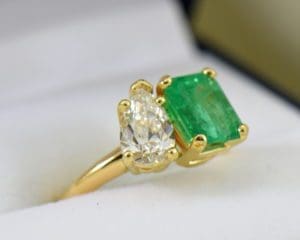
A Modern Era two-Stone Ring with Pear Diamond and Emerald Set in Yellow Gold Some modern jewelry designers actually “borrowed” styles from other cultures to give their
The Modern Era is what followed the mid century period and has continued to present day. When a client buys a piece of jewelry made in the last 50 years, it will be sold under one of a few monikers: estate jewelry, modern estate item, or pre-owned. These pieces often have history going back further- just as clients come in today and remount heirloom diamonds or redesign damaged pieces, jewelers of the 80s did too, so we often see estate jewelry set with antique Diamonds and gems. Designers of the last decades have been inspired by all eras and all cultures, thus there is a huge variety available. Some of these pieces are attractive and salable, or signed from a known maker, and have substantial value above their materials, but since estate items are not antiques from a known era, they often sell based on their component value (gold, diamonds, gems, manufacture costs) without the premium some antiques can cost. There is an incredible diversity of design, style, technique, gems, and price points available in this category- more than in any other, and as such, some of the best “deals” are found in estate jewels.
We hope you have enjoyed reading this article about Jewelry Through The Ages and the various periods that our antique jewelry comes from. This would be a good time to check out our prices and products in our online store. In the store you will be able to select and search through the various time periods. You are welcome to come in and shop our antique & estate collection in person, too.
Frequently Asked Questions
What is considered vintage in jewelry?
Jewelry is typically considered vintage if it is between 20 and 100 years old. These pieces often showcase styles and craftsmanship from their specific eras, making them unique and collectible.
How do you know what era your jewelry is?
You can determine the era of your jewelry by examining its design, materials, and any hallmarks or maker’s marks. Certain styles, like Art Deco or Victorian, have distinct characteristics. Consulting a jewelry expert or appraiser can also help identify its time period.
How old must jewelry be to be called vintage jewelry?
ewelry is generally classified as vintage if it is at least 20 years old but less than 100 years. Pieces over 100 years old are often categorized as antique.
How do you know what era your jewelry is?
You can determine the era of your jewelry by examining its design, materials, and any hallmarks or maker’s marks. Certain styles, like Art Deco or Victorian, have distinct characteristics. Consulting a jewelry expert or appraiser can also help identify its time period.

